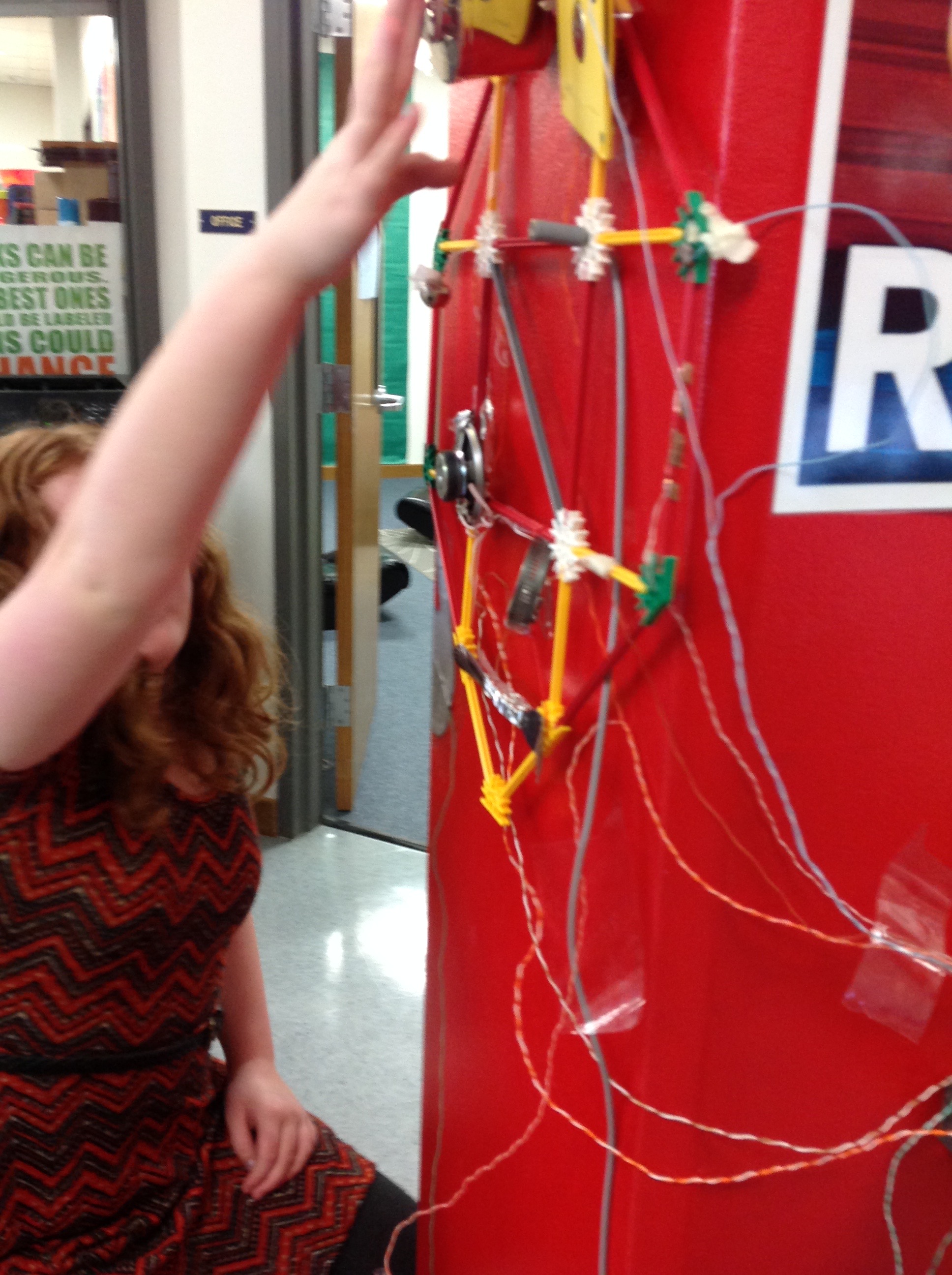Interactive Room Challenge With Makey Makey
by MakeyMakey in Teachers > Pre-K
2194 Views, 5 Favorites, 0 Comments
Interactive Room Challenge With Makey Makey


Based on the Musical Room by TedXYouth@Austin, Hackidemia, and HS students. This lesson will guide you with step by step instructions for making your classroom or library into an interactive space designed by your students!
Supplies
Makey Makey Classic, Alligator Clips Tinfoil Copper Tape Playdoh Anything conductive the students want to use for their interactive idea Key mapping software Soundplant (Use Vocaroo or Audacity to record sounds) or have students create sounds and map keys with Scratch (but students will need accounts and might be tempted to play games.) Prepared Telephone wires (see step #2)
Challenge Students


Some ideas for major objectives with this challenge:
- Introduce or Reiterate the TMI Design process from Invent to Learn - Think Make Improve
- Design and create an interactive space in the classroom or library
- Engage students in innovation and creation
- Entice students to create with technology rather than just consume it
- Teach key mapping software Soundplant or coding keys with Scratch
Educator Tip:
This is actually designed as a lesson plan for teachers, but hack it how you see fit!
Prepare Telephone Wires or Hook Up Wires


Prepare telephone wires by stripping the ends. Or use extra long hook up wires from our STEM pack.
Inspire Students to Get Creative


Inspire students with this video by Hackidemia and TedXYouth@Austin. Also show them Lamar Library's Musical Column, High Five Station, Musical Drawing, and Talking Book Drop.
1. Have students plan and design the interactive sections for your room. Brainstorm ideas and have students decide if they want the room to have musical aspects, sound effects, or a mixture of both.
2. Make sure you brainstorm ideas as a group so students can piggyback off one another's ideas. Also, a student might want to attempt an idea heard from another.
3. If using the key mapping software called Soundplant, have students view this tutorial to see how easy it is to connect student mp3s to specific keys on the computer.
Connect Sounds to Interactive Spaces
Choose keys and upload wav files or drag and drop wav files to desired keys.
Connect ports on Makey Makey to match keys programmed with Soundplant.
Or Code in Scratch

(Cont.) Alternatively, students can map keys by coding keys in Scratch. It's really easy. Just program the keys by recording sounds directly into Scratch or upload the sound you would like to use. (See this Getting Started Guide)
Make Connections
_500_5006446723032217296244.png)
Connect Wires to interactive spaces designed by students.
Create Earth or Switches
_500_5003766110604286109933.png)
Have students decide if they want to create a ground (Foil hand pictured below) or make a switch.
Put It All Together!
Begin the interactive room transformation.
- Give students time to create sound effects with Soundplant or Scratch.
- Hook Makey Makey ports (the keys your students programmed) to the interactive objects in the room.
- Create signs if needed to prompt interaction.
(Note: You can use one Makey Makey for multiple projects in one area. My "Interactive Column", "High Five Station", and "Book Drop Switch" all run off of one Makey Makey.)
Get Feedback, Make Changes!
Invite others to enjoy your room transformation! Then get some feedback.
- Have participants reflect on making the room.
- Have visitors reflect on experiencing the room
Making a Switch
Basic How to's for RookiesHow to create a switch
- To make a switch, you just have to attach an earth (ground) to one piece of foil and your key with desired sound to another piece of foil. Then place something in between (paper, bubble wrap,etc) to keep the two sides from completing the circuit. Here's a great guide for making a switch.
- In this example, a book presses the switch to trigger the sound from Soundplant.
- In this example, a balloon triggers the switch. (The switch is an aluminum face that the student dubbed, "Your mean boss!")
How to Make a High Five Station
A high five station is created similarly to a switch. You just need one conductive area attached to earth and another conductive area attached to the key with desired sound. The high fives complete the circuit!
How to Make an Interactive Sounds With Scratch



You can use a sound in Scratch, upload a sound, or record your own sound! All you need to do is connect a "When Key Pressed" block to each sound you want to play. For help getting started with Scratch and Makey Makey, use this handy guide!
How to Make an Interactive Drawing
Graphite is conductive! So that means you can make a pencil drawing and connect Makey Makey to different sections of your drawing. (But remember that your drawings can't connect or you'll short your circuit. Here are some guides that use drawings as conductive touch pads:
Extensions (Optional)
Extensions (optional)
Poetry Month
Program your room to be an immersive poetry experience for the month of April.
Dot Day
Have Elementary students create interactive dots for International Dot Day. Students can make dots and program Makey Makey to pencil drawings with a recording of "how students will make their mark" that plays when another student interacts with each dot.
Booktalks
Display books and create a switch on the book to do a book talk for students.
Have students read aloud their favorite sections of books and find a way to incorporate the recording and Makey Makey in their own way.
Celebrate diversity by displaying artifacts from different cultures for students to interact with.